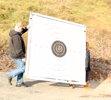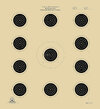Charlie Martinez
Member
When I first purchased my AR 15 I shot it strictly with peep sights. I soon noticed that slightly sub 2 MOA, 5-shot groups (around 1.8") were about the best I could manage shooting both .223 and 5.56 ammo. Later purchased a red dot sight (my first) and found that aiming was easier but my groups remained pretty much the same as before. I usually only use scoped bolt action rifles when I shoot at 100-yards so I'm relatively new at using irons or red dots at that distance so my questions are:
1. Is my rifle at fault or are my expectations too high if I'm a bit disappointed that I am not shooting tighter groups using red dot or irons?
2. If a rifle shoots 2" groups with iron or red dot sights and all else is equal (ie rifle, shooter, ammo etc.) what groups would the same rifle be expected to shoot with a good quality scope?
1. Is my rifle at fault or are my expectations too high if I'm a bit disappointed that I am not shooting tighter groups using red dot or irons?
2. If a rifle shoots 2" groups with iron or red dot sights and all else is equal (ie rifle, shooter, ammo etc.) what groups would the same rifle be expected to shoot with a good quality scope?



